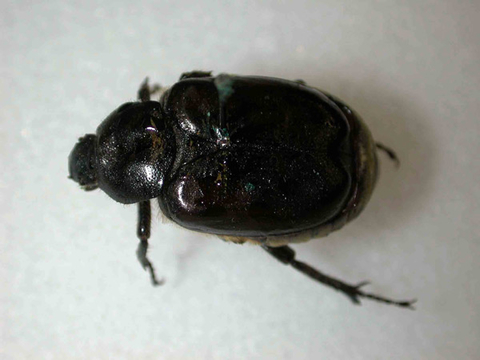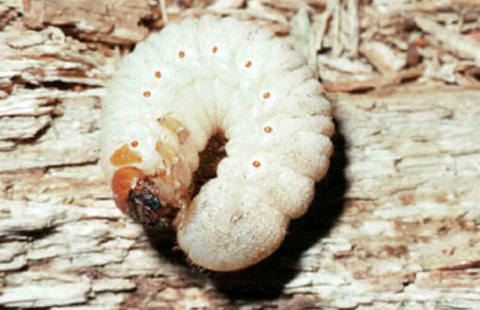Quick facts
- Scarab beetles are a common, diverse group of beetles.
- The larva or grubs of Hermit flower beetles feed on old, rotting wood.
- Grape pelidnotas are large beetles that mostly feed on grape leaves.
- Both beetles do not cause much damage to plants.
- No control is required.
Hermit flower beetle
(Osmoderma spp.)
There are three species of Osmoderma present in North America. Two of these are found in Minnesota. The most common is O.eremicola, commonly called the hermit flower beetle.
- They are beneficial insects that help to decompose wood.
- They are found in tree cavities filled with debris.
- Their larvae can be found in parts of trees with rotting wood.
Hermit flower beetles are associated with rotten wood from dead or dying trees, especially:
- Oak
- Maple
- Elm
- Apple
- Cottonwood
- Cherry
- Hickory
How to identify hermit flower beetles
Adults
- Dark brown to black beetle.
- Is similar to a June beetle, but not as oval.
- One inch in length.
- Present from July to September.
- Attracted to lights at night.
Larvae
- Larva has reddish brown head and six legs.
- It has a dirty whitish body, permanently curled into a C-shape.
- It grows up to two inches long.
- Grubs are found from August through the following spring.
Damage caused by hermit flower beetles
- These larvae are not pests and they do not cause trees to rot and die.
- The tree health declines and it dies due to some other reason.
- This insect takes advantage of weakened trees by feeding on the rotten wood.
Grape pelidnota
(Pelidnota punctata)
A grape pelidnota, also known as spotted grapevine beetle, is a type of scarab beetle. It is also known as spotted pelidnota or spotted June beetle.
- Grape pelidnotas can be found throughout the late spring and summer.
- They are found in wooded areas and sites next to these areas.
- They are active July through August.
- They mainly feed on grape leaves, sometimes feeding on the leaves of willow, poplar and oak.
- The adults are attracted to lights so you can see them around your home even if you don't have grapes.
How to identify grape pelidnotas
- Tan to reddish brown in color with three black spots on each wing cover.
- They are about one inch long, oval and robust.
- They look similar to June beetles, but are more closely related to Japanese beetles.
Damage caused by grape pelidnotas
- The adults feed on grapes, but they usually do not cause much damage.
- The larvae are associated with rotting hardwood tree logs and stumps.
- Grape pelidnotas are harmless to people and pets.
- Ignore them as they are not considered a pest.
- You can handpick them if they become numerous.
Reviewed in 2018




